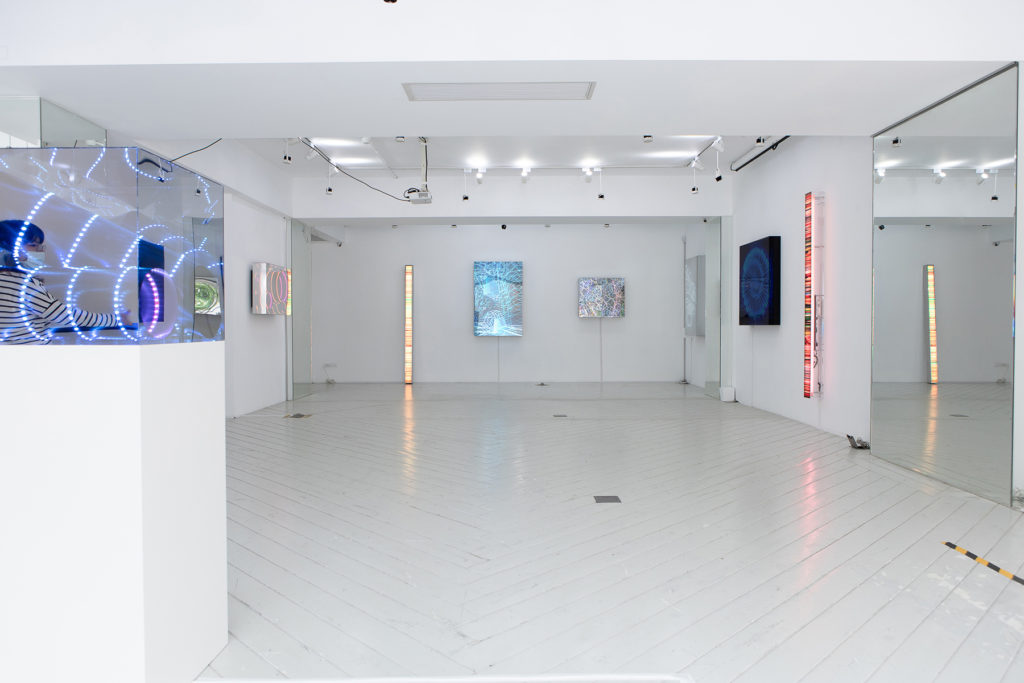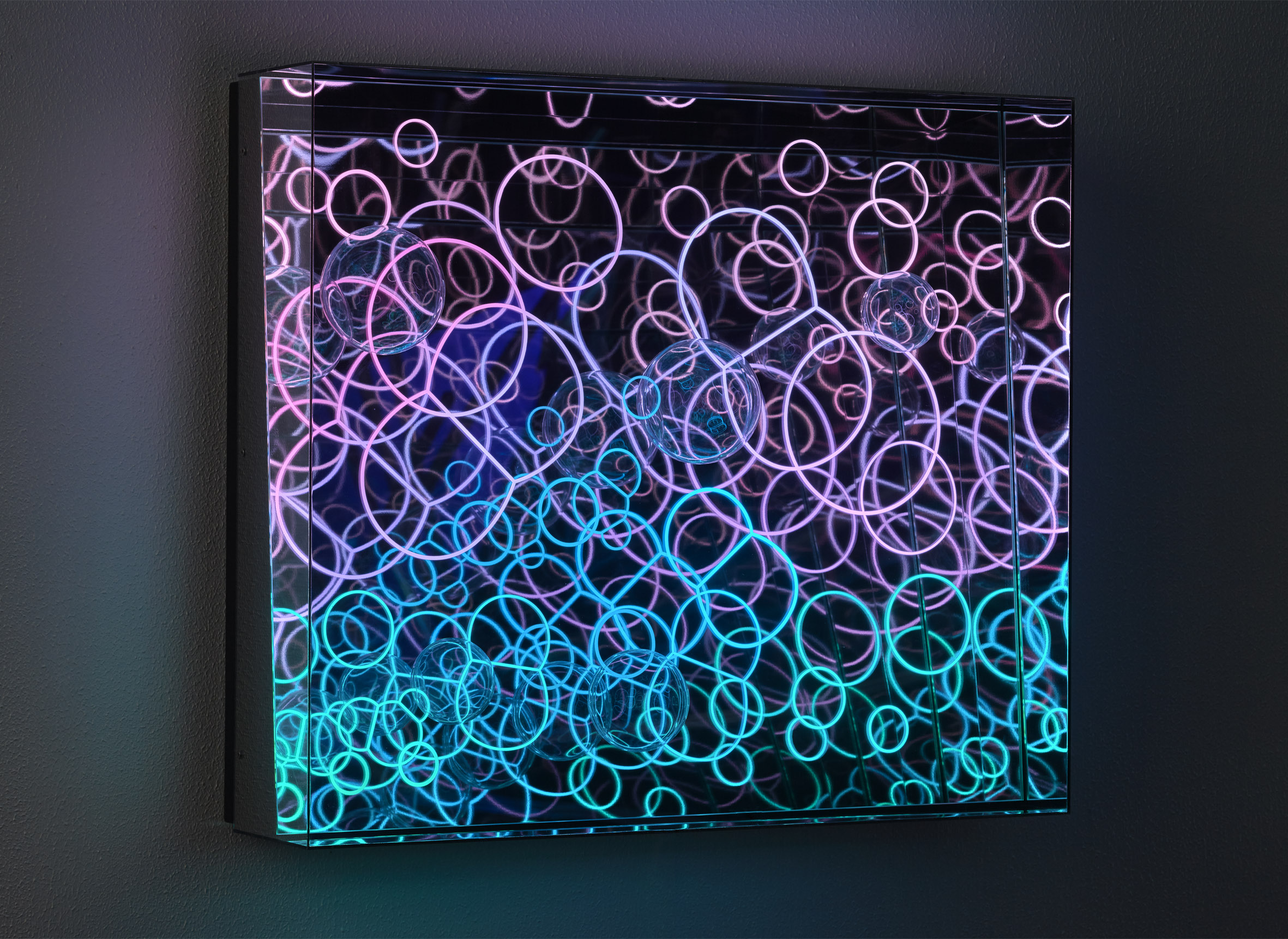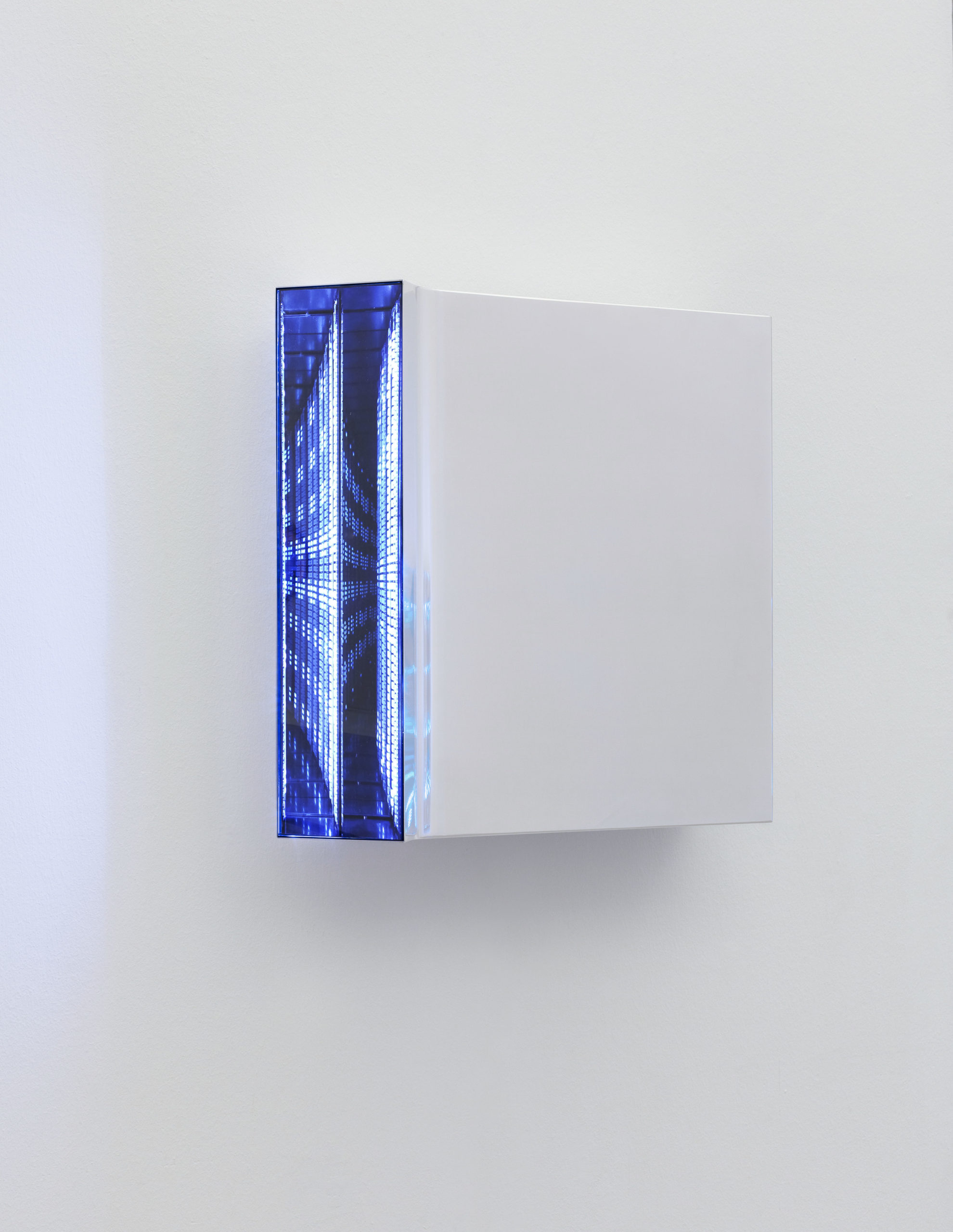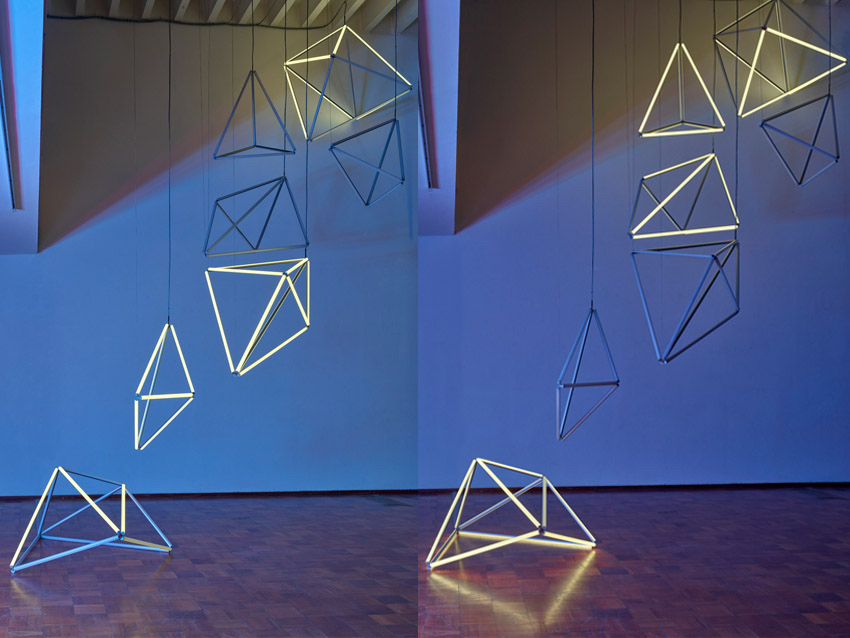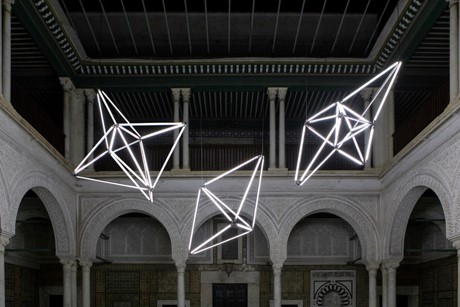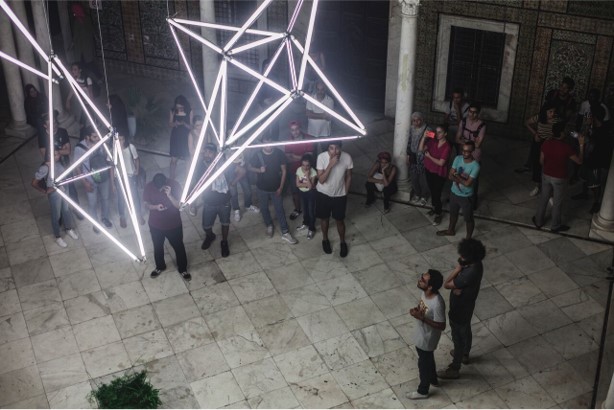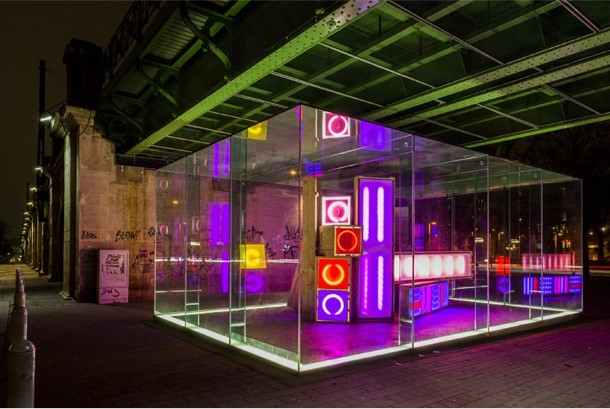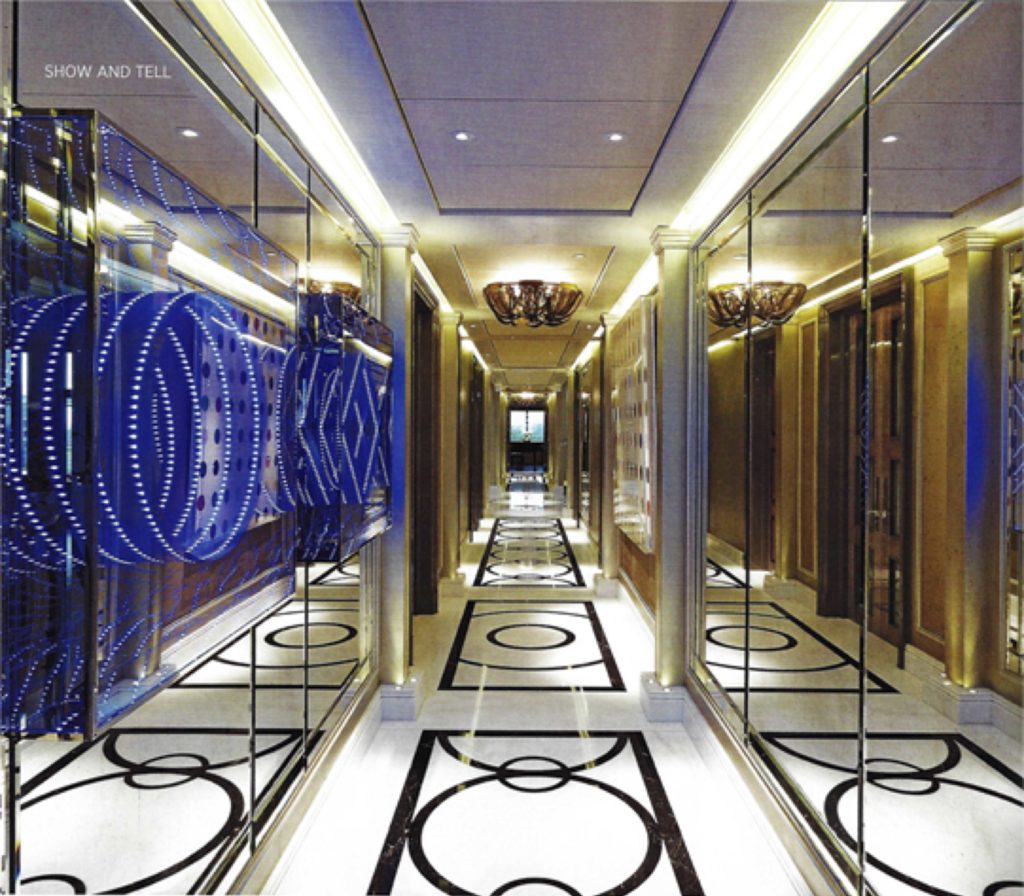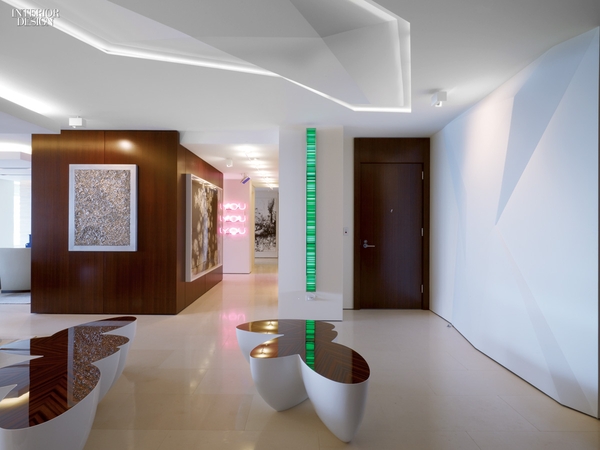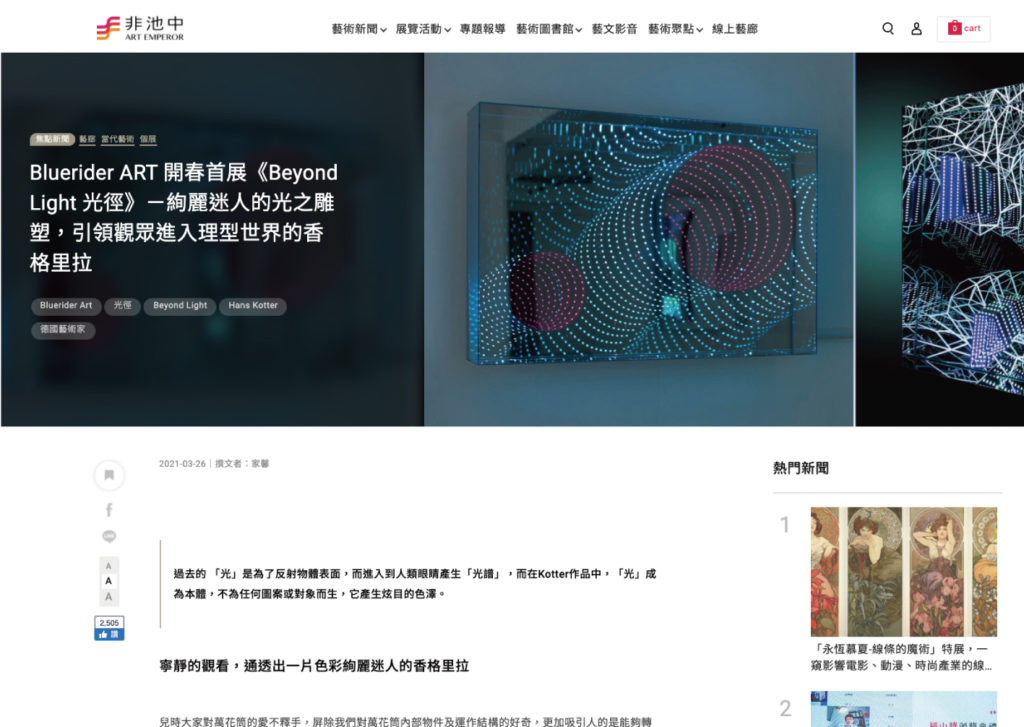

(Germany, b. 1966)
出生於德國巴伐利亞邦,就讀紐約藝術學院(Art Students League of New York) 畢業於慕尼黑媒體設計學院。現創作居住於柏林。2004年被授予「德國巴伐利亞文化獎」Bavarian Culture Award, E-ON藝術建築領域獎項。Kotter以燈光雕塑裝置創作為人所知。曾任德國斯圖加特國家藝術與設計學院講師,2014年獲得德國國際Unna燈光藝術中心的國際燈光獎項提名。德國著名藝術史學家Kai-Uwe Hemken 評論Hans Kotter 漢斯·卡特 作品:「Kotter 卡特 為觀者提供了作品的維度,是批判性、自我反省、與洞察導向,同時重新呈現了現代主義的基本烏托邦。」德國知名策展人暨藝術評論家Peter Lodermeyer則形容Hans Kotter 漢斯·卡特作品「充滿光的形式與鏡面平滑的作品,總是閃閃發光地乾淨與純粹」。Hans Kotter 漢斯·卡特目前持續在各國博物館展出,包括德國里特博物館、英國倫敦Kinetica博物館、德國科隆應用藝術博物館、德國科隆MAKK博物館..等。作品由義大利TARGETTI光之藝術典藏、德國立陶宛博物館、德國聯邦議會等眾多機構永久收藏。
Hans Kotter 於2020年3.11-4.26 於德國科隆應用藝術博物館(MAKK- MUSEUM OF APPLIED ARTS COLOGNE)展出個展 “Light- Colour- Space“
Hans Kotter 參與2018年突尼斯國際燈光藝術節 Interference
Hans Kotter 2013年於 維也納Kubus Export 展出
Tunnel View “Down Under”, Plexiglas, Metal, Mirror, LED Light with Colour Changes, 2011 (Museum Ritter收藏)
從小受到未來派畫家Umberto Boccioni以及 Op Art 歐普藝術Victor Vasarely吸引,藝術家 Hans Kotter 漢斯·卡特,一路的創作脈絡是複雜多元的。他不斷嘗試各種可能,從具象的繪畫到攝影、從觀念藝術到裝置藝術,反映出些許現代藝術流派的身影,像是歐普藝術(Op Art)的幻視,利用光學特性營造奇異的視覺效果,用特殊的線條、色彩排列組合造成視覺錯覺,或是低限主義(Minimalism)強調從材料的物性出發,呈現物件的真實樣貌,而非表現文化屬性,開放作品自身在概念上的限制,讓觀眾自主參與對作品的建構。 Hans Kotter漢斯·卡特認為公共藝術扮演著重要任務,是讓空間成為藝術過程的重要元素,他樂於邀請觀眾參與其中,期待讓觀眾在過程中感受到快樂。


Umberto Boccioni 

Victor Vasarely 

François Morellet
Hans Kotter 2008年於倫敦地鐵站 London Bridge Station 舉辦 Kinetica Museum, London開幕特展
Hans Kotter 漢斯·卡特作品中的生命力,來自於自身與材料之間的對話與互動,他曾提及自己的藝術創作之路是從「繪畫」開始,經過「攝影」才進展到當下的「光之雕塑」。創作靈感來自於真實的生活,使用油、水、壓克力、LED、有機玻璃、不鏽鋼、霓虹燈等材料創作,因為這些物質對於光的反應,都不盡相同。觀者可以從其過去多種形式的作品,來理解藝術家創作脈絡的蛻變: Still Lifes (1999)- 對應17世紀荷蘭靜物畫之繪畫性,以諷刺方式打破過去靜物之象徵意涵 。Landscape in Plastic (2000)- 藉由光線與空間的框架界定,交錯陳列童年記憶之物。Balance (2008)- 空間中的單一霓虹線條,營造靜謐氛圍。Big Bang (2014)- 將光物化,抓住宇宙自然起源的瞬間,也接取現實殞落的燎原星火。而知名作品 Point of View (2017)- 吸引觀眾進入空間錯覺萬花筒,迷失與尋找自我。透過「光」帶來幻象與衝突感。Kotter 卡特利用光線的對比與錯動,產生閃爍、流動、旋轉、放射運動,充分展現藝術創作技術的精準度,而精心設計的光線及動態,更引導人們進入目眩神迷的精神之旅,挑戰觀者自由想像、體驗雋永的光之奇觀。


Big Bang|2013| 210 × 155 × 87 cm 


Point of View | 2019 | Each 55 cm x 38 cm | lide on Plexiglas, LED, Metal Light box
Private Collection
Selected Solo Exhibitions
2021 Bluerider ART, Taipei, Taiwan, Beyond Light
2020 De Buck Gallery, New York, MAKK: Selections
2020 Light, Colour, Space, Museum of Applied Art, Cologne, Germany
2020 Futurs Antérieurs, La Chapelle, Chaumont – FR
2020 Regards d’Artistes, Château d’Aunoy, Champeaux – FR
2019 The Invisible Generation, Galerie Pascal Janssens / Keyes Art Mile,
Johannesburg – SA Crackography, Galerie Pascal Janssens, Gand – BE
2018 Leuchtende Unendlichkeit / Luminous Infinity, Galerie Michaela Stock, Vienna, Austria
2018 More Light, Stern-Wywiol Galerie, Hamburg
2017 Point of View, Patrick Heide Contemporary Art, London, Great Britain
2016 Beyond light, Samuelis Baumgarte Galerie, Bielefeld, Germany
2015 Beyond light, Bildraum 07, Vienna, Austria
2014 Light Flow, Galerie Nery Marino, Paris, France
2014 Interruption, De Buck Gallery, New York City, NY, United States
2013 Superposition, Galerie Michaela Stock, Vienna, Austria
2013 Replaced – light flow, Kubus Export, Vienna, Austria
2013 Light flow, Osthaus Museum Hagen, Hagen, Germany
2012 Home sweet home, Galerie Klaus Benden, Cologne, Germany
2012 In the flux, Galerie Nery Marino, Paris, France
2011 Light flow, Patrick Heide Contemporary Art, London, Great Britain
2011 Light sensitive, De Buck Gallery, New York, United States
2011 Point of view, Priveekollektie, Heusden aan de Maas, Netherlands
2011 Deflection, Studio d’Arte Contemporanea Pino Casagrande, Rome, Italy
2010 Transformation, Priveekollektie, Heusden aan de Maas, Netherlands
2009 Replaced, Patrick Heide Contemporary Art, London, Great Britain
2009 Replaced, Galerie Michaela Stock, Vienna, Austria, (catalogue)
2008 The very best…, Gallery Benden & Klimczak, Cologne, Germany
2008 Balance, Shunt London, Great Britain, with Kinetica Museum London, Great Britain
2008 Colour rush, Gallery Bernd Lausberg, Toronto, Canada
2007 Ccolour rush, Patrick Heide Contemporary Art London, Great Britain, (catalogue)
2006 Luminale Frankfurt, Germany – Biannual light culture festival, with Patrick Heide
Contemporary Art London, Great Britain
2006 Licht Farbe Raum, Gallery Bernd Lausberg, Düsseldorf, Germany
2005 Chromatic impulse, Berlinische Galerie with Company Spectral, Germany
2004 Balance, Raum für Kunst/Art space, Art Association Ravensburg, Germany
2004 Illuminations, Aedes, Berlin, Germany
2004 Macro landscape, Patrick Heide Contemporary Art, London, Great Britain
2003 Lichtecht/lightfast, Patrick Heide Contemporary Art, Frankfurt, Germany
2002 Light and colour, Bezirks Galerie Oberbayern/Gallery District Upper Bavaria,
Munich, Germany
2002 Beauty in plastic, City Museum Neuötting, Germany
2001 Blue line, Factory Pasinger, Munich, Germany
1999 Stillleben, Gallery Benden & Klimczak, Cologne, Germany
1998 Spurensicherung, City Gallery in the House of Culture, Waldkraiburg,
Germany
1997 Diary with sound-collage, Modern Theatre Munich, Germany
1997 Tagebuchnotizen, Gallery Hofmeisterhaus, Massing/Rottal, Germany
1994 Body language, Radio centre of Bratislava, Slovakia
1993 Stadtmuseum Waldkraiburg, Waldkraiburg, Germany
1993 Daydreams, Chuck Levitan Gallery, New York, United States
Selected Group Exhibions
2020 Bluerider ART, Taipei, Taiwan, Switch ON
2020 JD Malat Gallery, London, Shifting space
2020 International Light Art Project, Cologne, Germany, Collumina II
2020 Valletta Contemporary, Malta, up to now
2020 Algorithm & Appropriation, Bluerider Ren-Ai Gallery, Taipei – TW
2020 Hemera, IBU Gallery, Paris – FR
2019 The Invisible Man, Wood Street Galleries, Pittsburgh – USA
2019 Linha Atemporal, Dan Galeria, São Paulo – BR
2019 ArtJaws, Zurcher Gallery, New York – USA
2019 Einsichten IV, Galerie Hengevoss-Dürkop, Hamburg – DE
2019 Cape Town Art Fair, Galerie Pascal Janssens, Cape Town – SA
2019 SP-Arte, Dan Galeria, São Paulo – BR
2019 Art Paris, Galerie Hengevoss-Dürkop, Paris – FR
2019 Wechselspiel, Pforzheim Galerie, Pforzheim – DE
2019 Mutatio, Garage Amelot, Paris – FR
2018 Infinity by Hans Kotter & Annett Zinsmeister, MPV Gallery,
‘s-Hertogenbosch, Netherlands
2018 Mehr Licht! Stern-Wywiol Galerie, Hamburg, Germany
2018 LIGHT BOX – 18 aktulle Positionen, Kunstmuseum Celle, Germany
2018 Interference. International Light Art Project, Medina, Tunis, Tunisia
2018 A to Z. Works from the Collection, LH2 contemporary, Berlin, Germany
2018 Geometrics + Reflections, LH2 contemporary, Berlin, Germany
2017 Licht und Bewegung, Messmer Kunsthalle, Riegel am Kaiserstuhl, Germany
2017 PAD London, with Adrian Sassoon Gallery, London, Great Britain
2017 Art Berlin, with Gallery Klaus Benden, Cologne, Germany
2017 Colored Light | Summer Select, De Buck Gallery, New York, United States
2017 Dallas Art Fair, With De Buck Gallery, New York, United States
2017 THE THIN VIEL – Kinetica Anniversary Show, Kinetica – Museum of
Kinetic Art, London, Great Britain
2017 SIGNAL – Lichtkunst aus der Sammlung Robert Simon, Kunstmuseum Celle,
Germany
2016 Luminous perception, Galerie Michaela Stock, Vienna, Austria
2016 SPATIAL MIRACLES Installations, Spatial Constructions, Light Sculptures,
Museum
2016 Ritter, Sammlung Marli Hoppe – Ritter, Waldenbuch, Germany
2016 Sculpture en partage, Foundation Villa Datris, L’Isle-sur-la-Sorgue, France
2016 Deck Voyage, Borusan Contemporary, Istanbul, Turkey
2015 Lumiere & Lumieres, Galerie Nery Marino, Paris, France
2015 Lunapark 2000, Museum Ritter, Waldenbuch, Germany, Germany
2015 Appropriation, Galerie Michaela Stock, Vienna, Austria
2014 Contemporaries, New Budapest Gallery, Budapest, Hungary
2014 Couleur et transparence, Galerie Nery Marino, Paris, France
2014 Common Ground: Earth, Borusan Contemporary, Istanbul, Turkey
2014 Insanitus Festival 2014 – Insanitus Festival, Vilnius, Lithuania
2014 Geometriks, Galeria Impakto, Lima, Peru
2014 Kinetica Museum feature show – Kinetica, Museum of Kinetic Art, London,
Great Britain
2014 Summer Selections, De Buck Gallery, New York City, New York, United
States
2014 Scheinwerfer. Part 2, Light art in Germany in the 21. century, Kunstmuseum
Celle, Germany
2014 Out of our Heads, ARTinTRA, London, Great Britain
2014 Cielo y Tierra, Galeria Impakto, Lima, Peru
2014 LUMINALE 2014, bestregARTs, Frankfurt/Main, Germany
2013 The Art of Light and Movement in the Marli Hoppe-Ritter Collection,
Museum Ritter, Waldenbuch, Germany
2013 Scheinwerfer. Part 1, Light art in Germany in the 21. century, Kunstmuseum
Celle, Germany
2013 Ceci n’est pas une lampe.., Gesellschaft für Kunst und Gestaltung, Bonn,
Germany
2013 BRIGHT Ideas, Galerie Nery Marino, Paris, France
2013 Segment #3, Borusan Contemporary, Istanbul, Turkey
2013 Kotter luther mack, Patrick Heide Contemporary Art, London, Great Britain
2013 Lumino Citiy – Galeria Impakto, Lima,Peru
2012 Quadratic equations, Kepes Institute, Budapest, Hungary
2012 Mouvement et lumiere, Villa Datris, L´Isle-sur-la-Sorgue, France
2012 Luminale frankfurt – shine shine shine, Bestregarts, Frankfurt/Main, Germany
2012 Effects in relation, Galerie Lisi Hämmerle, Bregenz, Austria
2011 New works 2011, Bestregarts, Frankfurt/Main, Germany
2011 Reflection reflected, NEXT DOOR galerie michaela stock, Vienna, Austria
2011 Stories for reflection, Galerie Michaela Stock, Vienna, Austria
2011 Segment #1, Borusan Contemporary, Istanbul, Turkey
2011 Summer group show, Patrick Heide Contemporary Art, London,Great Britain
2011 Summer selections, De Buck Gallery, New York City, New York, United
States
2011 Lazareti – artist in residence, Art radionica Lazareti – Gallery Otok,
Dubrovnik,Croatia
2011 Click clique, Galerie Lausberg, Toronto, Canada
2011 Sculptures plurielles, Villa Datris, L´Isle-sur-la-Sorgue, France
2011 Sensitiv EXTRA, MSU Museum of Contemporary Art Zagreb, Zagreb,
Croatia
2011 Deflection, Gábor ERDÉLYI & Hans KOTTER – Viltin Gallery, Budapest,
Hungary
2011 Konkrete abstraktion, Bernd Lausberg Gallery, Düsseldorf, Germany
2010 Dialog, Galerie Grazia Blumberg, Recklinghausen, Germany
2010 Beyond painting, Gallery Bernd Lausberg, Toronto, Canada
2009 Best of lausberg contemporary, Gallery Bernd Lausberg, Toronto, Canada
2009 Trilogie: berlin – london – rome, artMbassy, Berlin, Germany
2008 Best before…, City Gallery Klagenfurt, Austria
2008 Infected, Priveekollektie, Heusden aan de Maas, Netherlands
2008 Play it, Art Foundation Baden-Württemberg, Stuttgart, Germany, curator:
Werner Meyer (Kunsthalle Göppingen)
2008 Targetti art – light art collection, Florence, Italy
2008 German photography Today, Gallery bkhf, Miami, United States
2007 Preview 2008, Gallery Benden & Klimczak, Cologne, Germany
2007 Obsession durch Technik, ArtMbassy, Berlin, Germany
2007 Suitcase, Italian Culture Institute, Cologne, Germany
2007 In the flux, Kinetica Museum London, Great Britain
2007 Best before…, Art Association Aschaffenburg, Germany
2006 Life forms, Kinetica Museum, London, Great Britain
2006 Fire and ice, Rosenbaum Contemporary, Boca Raton, Florida, United States
2005 Reflections, Gallery Kashya Hildebrand, Geneva, Switzerland
2005 Rot als farbe, Gallery Bernd Lausberg, Düsseldorf, Germany
2005 Spectrum, Gallery Kashya Hildebrand, New York, United States
2005 Look!, ArtProject Berlin, NY Arts Magazine, Berlin, Germany
2005 Solaris, Gallery Kashya Hildebrand, Zurich. Switzerland
2003 Lichtung II, Bake-Factory, Berlin, Germany
2001 Kraft und magie, Upper Bavarian Culture Days, Altötting, Germany
2000 Culture Model, Passau, Germany
2000 Große kunstausstellung, Haus der Kunst/Art House, Munich, Germany
2000 City Gallery in the Park, Viersen, Germany
1999 The museum as muse: artist reflect, Museum of Modern Art, New York
(United States), Online-Exhibition
1999 Snapshot, exhibition on tour taking pictures: Siemens AG, Munich
(Germany), City
1999 Gallery Regensburg (Germany) & Gallery Monique Goldstrom, New York
1998 Country without borders, Gallery Abraham Lubelski, New York, United
States
1998 New Gallery Oberhausmuseum, Passau, Germany
1997 Keine erinnerung, Old Revenue Office, Rosenheim, Germany
1997 The power of words and signs, exhibition on tour: Gallery Casa, Tokyo
(Japan), Gallery
1997 Index, Osaka (Japan), Sala Franco, Triest (Italy), Gallery Abraham Lubelski,
New York
1997 Metamorphosia, Culture Model, Passau, Germany
1997 Biennale New York, NY Arts Magazine, New York, United States
1996 Sonic identity, 450 Broadway Gallery, New York, United States
1994 Annual art exhibition, City Museum Waldkraiburg, Germany
1994 Cyber culture, Gallery Dariusz Gubala, New York, United States
1993 vertigo art, Gallery Dariusz Gubala, New York, United States
1993 Gallery Madelyn Jordon, New York, United States
Art Fairs
TEFAF Maastricht, TEFAF New York, Art Berlin, Art Cologne, Art Central Hong Kong, Viennafair, Arco Madrid, Arte Fiera Bologna, Design Miami, Design Miami/Basel, Art Forum Berlin, Collect London, Art Moscow, Art Toronto, Art Amsterdam, PAN Amsterdam, Art Fair Köln, Art Miami, Art Palm Beach, Kunst Zurich, Art Frankfurt, Scope London, Scope New York, MiArt Milan, Kinetica Art Fair London, Kunst Köln, Pulse NY, Pulse Miami, Art Karlsruhe, P.A.D London, P.A.D. Paris, P.A.D. New York, Art Bodensee, LA Art Show, Object Rotterdam, Art Chicago, Parc Lima, Art Wynwood, Art Dubai et al.
Collections
MAKK Museum, Cologne, Germany
Targetti Light Art Collection, Italy
Collection of the German Federal Parliament, Germany
Museum Ritter, Germany
Osthaus Museum, Germany
Kunstmuseum Celle, Germany
Villa Datris, Fonds pour la Sculpture Contemporaine, France
Borusan Art Collection, Turkey
Collection Fidelity Investment, United Kingdom & United States
Collection DEKA Bank, Germany
Collection Candy & Candy Hyde Park One, United Kingdom
Collection Ron Dennis, United Kingdom
Kinetica Museum, United Kingdom
Collection Jean et Colette Cherqui, France
Collection Ichikowitz, South Africa
Collection Aareal Bank, Germany
Collection Jan des Bouvrie, Netherlands
Collection Heubeck, Cologne, Germany
Topping Rose House’s Collection, Bridghampton, New York
Collection Gerald and Jody Lippes, Naples, FL, USA
University of Texas Southwestern Medical Center, Dallas, TX
AT&T Collection, Dallas, Texas
Public Art
2010 Warburg Pincus, Frankfurt, Germany
2009 Aareal Bank, Hamburg, Germany
2007 Booz Allen Hamilton GmbH, Berlin, Germany
Hotel Maximilian, Nürnberg, Germany
School in Bavaria, Germany
2005 Immobilien Investment Frankfurt, Skyper, Frankfurt, Germany
Derag AG, Hotel Kanzler, Bonn, Germany
2004 E-ON Bayern Regensburg, administration building, Regensburg, Germany
Neuga Bauträge, object at Burghauser-Tor, Neuötting, Germany
2003 DEKA Immobilien Investment Frankfurt, Leomax, Munich, Germany
Staatliches Hochbauamt Rosenheim, land surveying office, Germany
1999 Passauer Neue Presse, media center, Passau, Germany
1998 Stadt Burghausen, community center, Burghausen, Germany
Passauer Neue Presse, editorial office, Passau, Germany
1997 Wochenblatt Burghausen, editorial office, Burghausen, Germany

 美麗佳人:BlueriderDaily 媒體 一向掌握藝術性及潮流敏感度的Bluerider ART 本月帶來Hans Kotter燈光藝術展
美麗佳人:BlueriderDaily 媒體 一向掌握藝術性及潮流敏感度的Bluerider ART 本月帶來Hans Kotter燈光藝術展
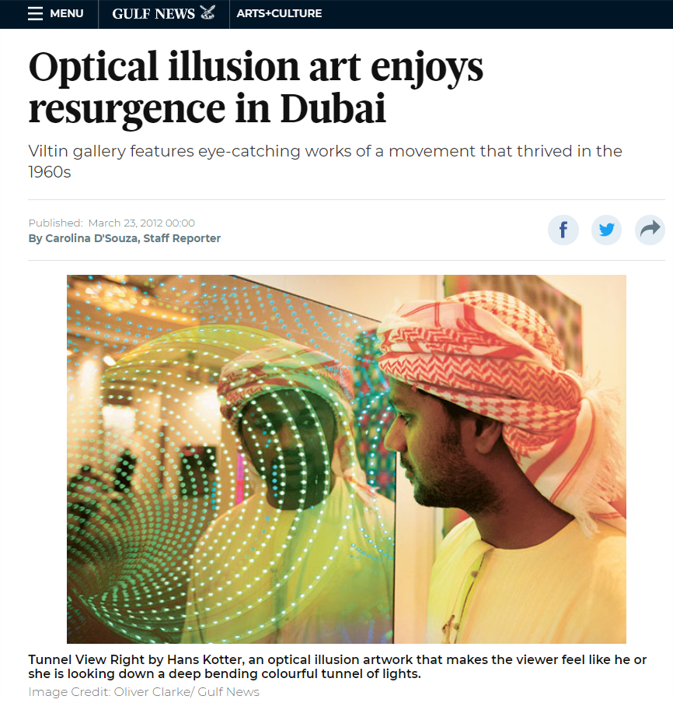 Gulf News:Optical Illusion art enjoys resurgence in Dubai
Gulf News:Optical Illusion art enjoys resurgence in Dubai
 D LUX Magazine
D LUX Magazine


 Artam Gloab Art & Design
Artam Gloab Art & Design
 Inhabitat:Hans Kotter Makes Brilliant Light Installations With LEDs
Inhabitat:Hans Kotter Makes Brilliant Light Installations With LEDs
 TEFAF NY
TEFAF NY
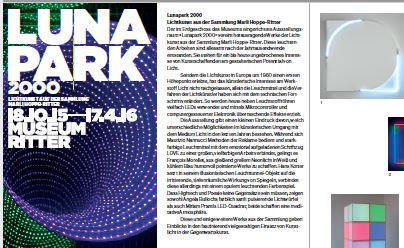 Museum Ritter
Museum Ritter
 Museenkoeln
Museenkoeln
 Magazine Boat International
Magazine Boat International
 Hyde Park one
Hyde Park one
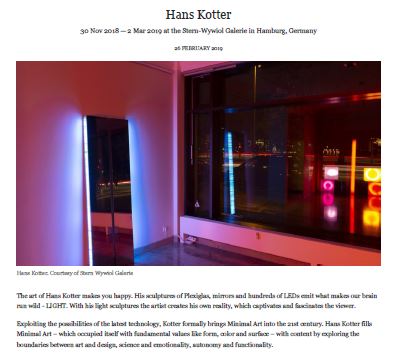 Wall Street International Magazine
Wall Street International Magazine
 G&G Magazine
G&G Magazine
 AD Spain
AD Spain
 Architext Magazine
Architext Magazine


